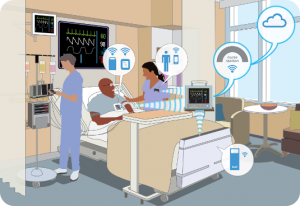
Penn Medicine Tests Wearable Patient Monitor in Hospital
Published on July 31, 2015

Lately there has been a lot of discussion surrounding the Connected Hospital. From the latest news stories to market forecasts, the concept is gaining ground and quickly becoming a reality in healthcare. The foundation of the Connected Hospital is mobility via wireless technology. Wireless technologies in hospitals allow caregivers, patients, and devices to roam throughout the hospital freely without sacrificing accuracy or reliability. In the Connected Hospital, every device is connected and communicating with the Electronic Health Records (EHRs) for accurate patient records and real time data analysis. Within the Connected Hospital nurses can monitor many patients remotely from one main station, receiving alerts and observing data captured each second on the patient’s health. Nurses closely monitoring patients from a central station saves them time on administrative tasks and allows the patient more time to rest and feel more comfortable not being tied down by wired medical devices.
In addition to providing wireless connectivity to existing medical devices, wireless technology is also fostering the creation of an entire new wave of medical devices. For instance, last week MedCityNews published an article on The University of Pennsylvania Health System which is testing its first continuous wearable patient monitoring device. Over the course of three weeks, Penn Medicine will test the FDA- approved monitors on real patients in a hospital ward. The wearable is an FDA-approved hospital device, not intended as a consumer device, and is worn on the arm. The Pilot is intended to prove the effectiveness of wireless devices in hospitals as well as to see if clinicians and patients like the monitors. In the article, Associate CIO Jim Beinlich says, that with this monitor, nurses don’t have to wake you up to measure blood pressure, which changes nursing workflow. Vitals can be taken remotely from a central nurses’ station rather than having to visit each bed, giving patients a better chance of sleeping through the night.
Remote monitoring can also help immensely in reducing the amount of time spent manually entering patient information. Medical device connectivity solves this problem by automatically sending data from devices to the EHR, saving nurses time and increasing productivity. In fact, connecting medical devices to EHR systems has reduced the time it takes to enter vitals from 7-10 minutes to less than 1 minute per patient. Unfortunately given the relatively short time frame of the study, Penn Medicine’s nurses will have to manually collect and enter data. However, if the trial is a success and the new technology is deemed “more practical and cost-effective than traditional systems” then IT may consider integrating the monitors to EHRs.
Wireless in hospitals will continue to develop in the coming years, making security and reliability of all wireless devices imperative. Here at Laird, we’ve always recognized the importance of wireless in hospitals and over the years we’ve researched and developed resources on the Connected Hospital. Check out our videos, infographics, and more on the Connected Hospital webpage and don’t forget to subscribe for weekly posts on the wireless industry!
Check out the full MedCityNews article, here.
 Laird Connectivity is now Ezurio
Laird Connectivity is now Ezurio